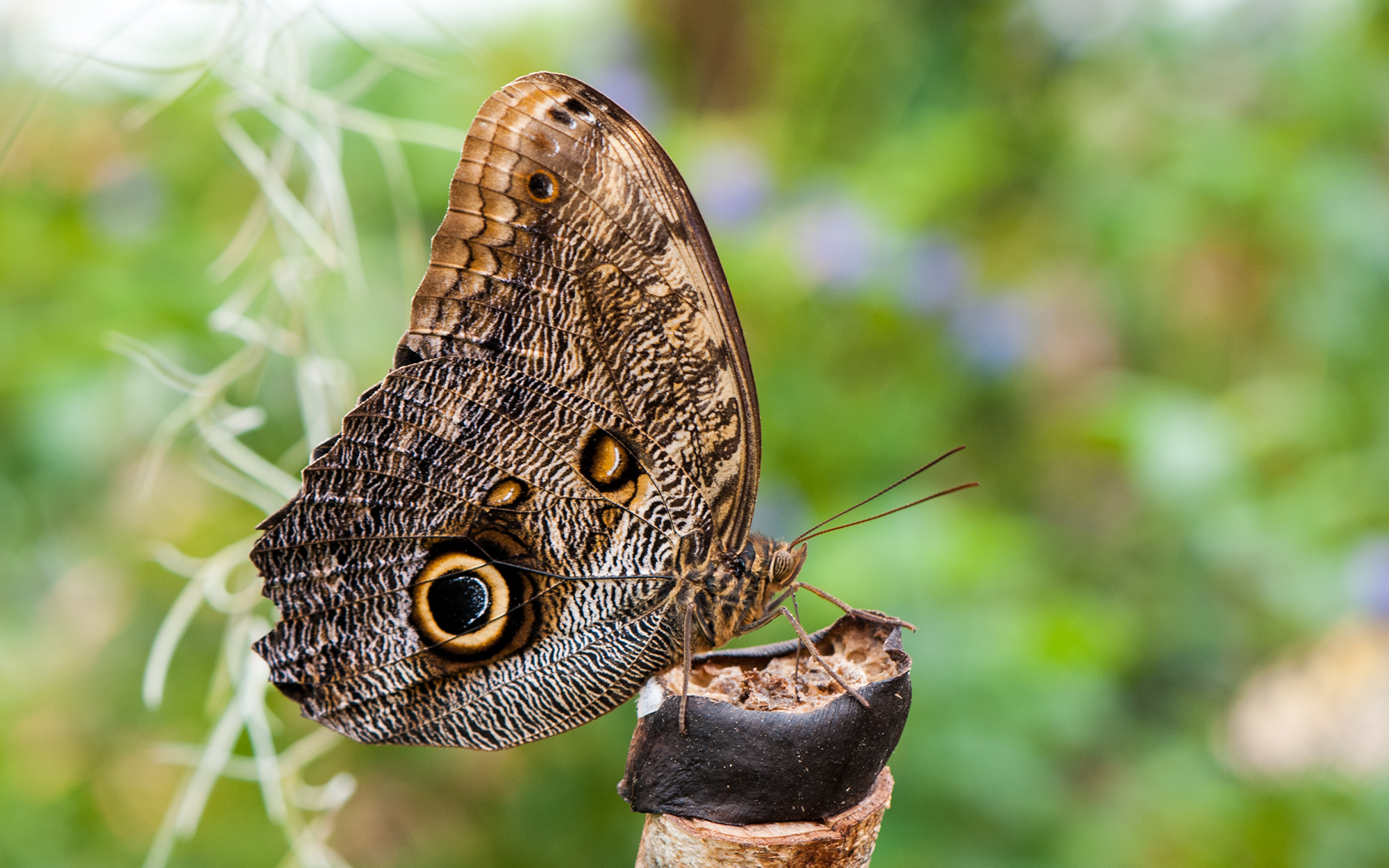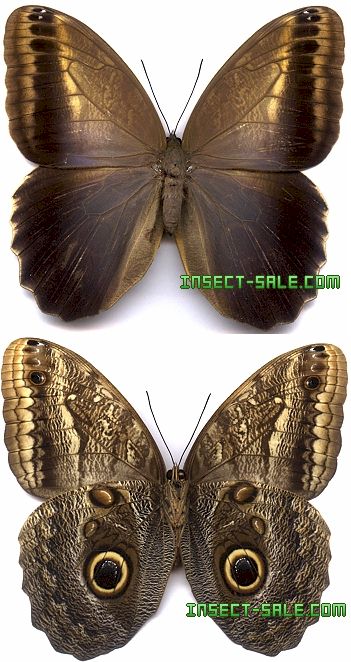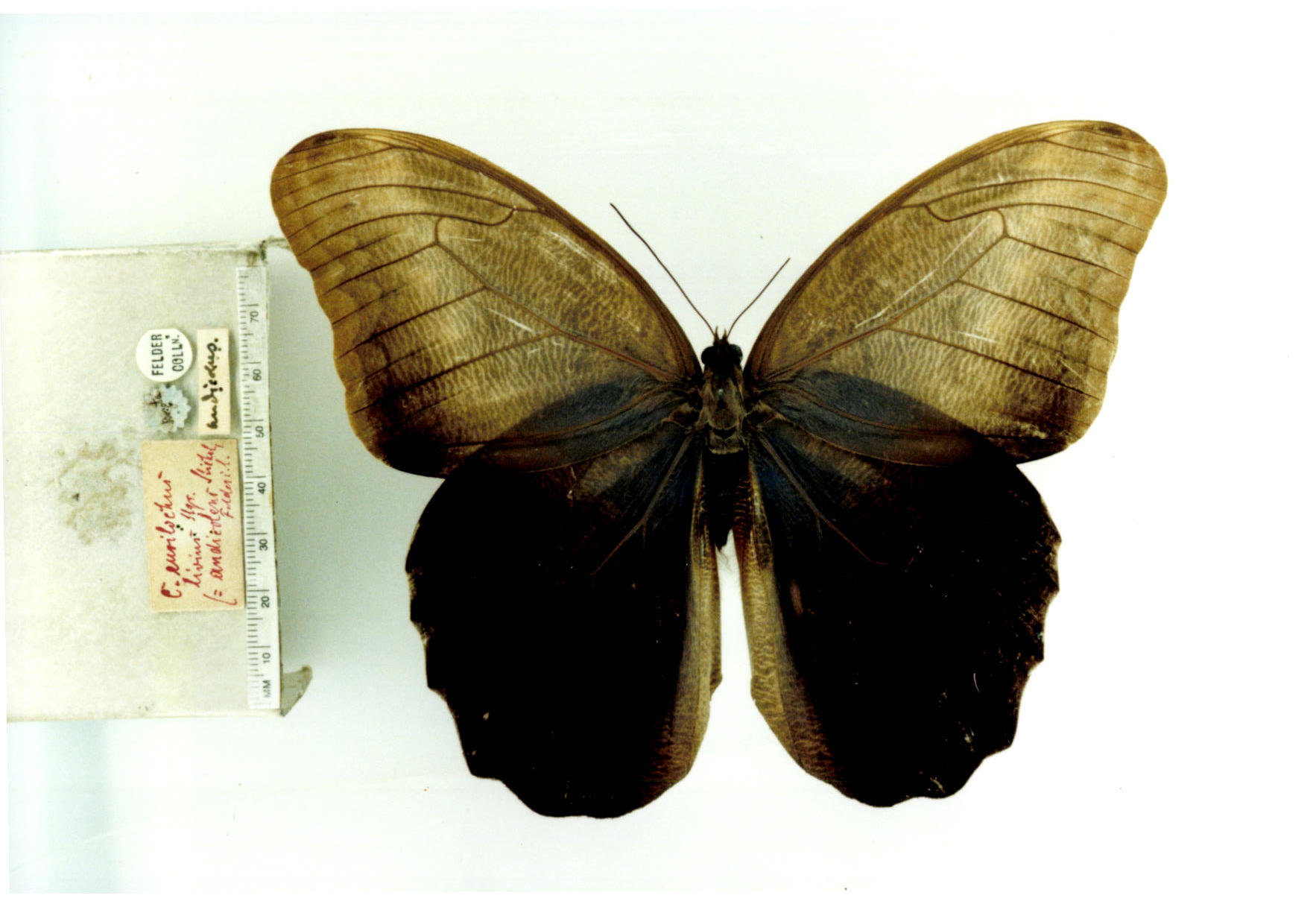Caligo eurilochus
Owl butterfly ( Owl Butterfly )
Owl Butterfly is a butterfly ( butterfly ) of the family Nymphalidae ( Nymphalidae ). Like the other moths of the genus Caligo he is called on German Bananenfalter.
Features
The moth has a span 10 to 13 centimeters and has a brown color. The upper wing surface of the front wing is partially doused beige. For the outer edge Beige is weaker, the inner angle the base color goes to black. The upper side of the hind wings is black. Both pairs of wings of the males shimmering dark blue, the intensity increasing to the basal region.
The undersides of the wings are contrasting brown, black and cream patterned. On the hind wings, there is one big dark brown eye spot, the beige thin and is framed in black. One to two smaller eyespots are located in front of it toward the front edge of the hind wing. A small eye-spot with blue black core and a russet ring is located near the wing tip of the forewing. Through their attention to detail are the large eyespots of Caligo species to the best imitations of eyes in animals. This is also true especially for Owl Butterfly to. The dark core with a bright half-ring on it and the bright rim are strongly reminiscent of a bright iris with dark pupil, which has a light reflection. It can be interpreted as an owl eye, which is surrounded by a simulated plumage structure, so the Caligo species are also known as cutworm; not to be confused with the actual owl butterflies. However, it is debatable whether these eyespots mimic the eyes of a given animal or whether they serve as secondary protection if a predator comes too close. Primarily, the animals are protected by their high-contrast patterns on the wing underside, a Rindenmimese if they rest during the day with closed wings on tree trunks.
Features of the crawler
The Eiraupen are white and have two red stripes. The horns loose head capsule is light brown and the forked end of the body is already clearly visible. After the initial skinning, in the second larval stage (L2), the beads are colored green and have the outer shape of the later larval stages. These caterpillars have a flat, slightly hairy body. At the head capsule carry four pairs of rearward horns with fine hairs that are longer from the outside inwards. The end of the body has a hairy tailed. On the back there are up to six black spines, the middle are slightly larger. From L4, the caterpillars are dark brown in color. In Ecuador, they are then called la vaquita negra ( black calf ).
Young caterpillar with green color on an eroded banana leaf
Mature caterpillar with brown color on a banana tree
Doll of Owl Butterfly
Similar Species
- Caligo memnon, fields, 1866
- Caligo brasiliensis, fields, in 1862, was still regarded as a subspecies of C. Prick of eurilochus and is now considered a separate species. Widespread in central and southern Brazil.
- Caligo illioneus, Cramer, 1776
- Caligo idomeneus, Linnaeus, 1758
Caligo idomeneus
Occurrence
Owl Butterfly is eurolichos used in Guyana, Suriname, French Guiana and in the eastern and central Amazon of Brazil.
Spread of subspecies:
- C. eurilochus livius, Staudinger, occurs in the western Amazon
- C. eurilochus caesia, graver, occurs in Venezuela and Panama
- C. eurilochus sulanus, Fruhstorfer, 1904, occurs in northern Panama and Guatemala
- C. eurilochus galba occurs in Colombia
- C. eurilochus morpheus, stylus 1903, is found in southern Colombia, Ecuador and Peru.
Way of life
The ball round white eggs are laid by the females individually or in small groups at the bottom of the food plants. In addition to bananas, which only came with the Europeans to America that eat caterpillars heliconias. The caterpillars are nocturnal and spend the day sleeping in colonies on the midribs of the leaves of the food plants. The green beads are well adapted to the sheets. Older caterpillars are brown as banana stems, or the apparent strains of heliconias and their sleep because colonies are thus difficult to detect. For the stay at the leaves they are at this stage too big and flashy. Since no inedible or toxicity of the caterpillars is known to be a good cover is the only way for the caterpillars to protect themselves from predators.
The caterpillars are about 13 inches long by four molts and walk restlessly about two days before pupation. Then customize a web to a stable point of the food plant, where the fasten, before they pupate a few days later to a four to five inches long, edged Stürzpuppe. After about five weeks, the moths hatch.
The adults often suck in the company of fermenting fruit in the undergrowth area where their subdued colors give them good protection. If the moths find enough food, they can be up to seven weeks old. The moths are active at dawn and sit during the day often with closed wings on tree trunks.
In banana plantations Owl Butterfly can become a pest, although eight kinds of Parasitioden ( Hymenoptera and Diptera ) are known.




.jpg)




